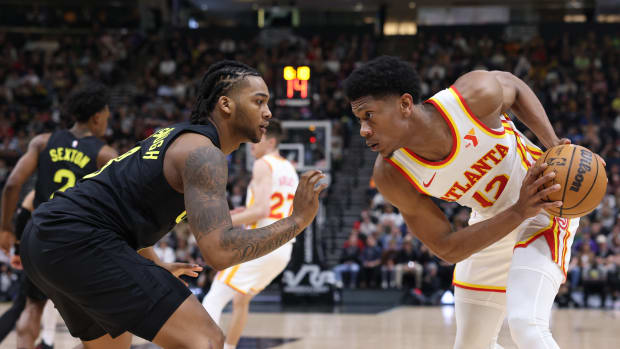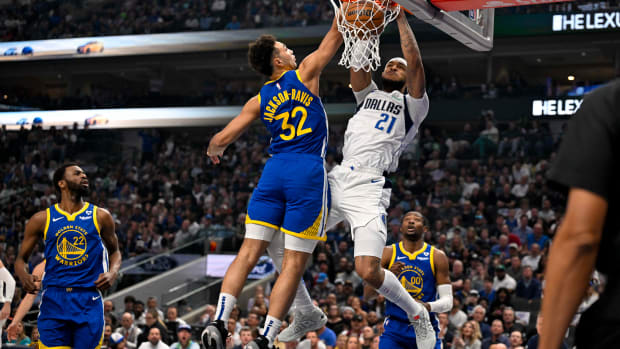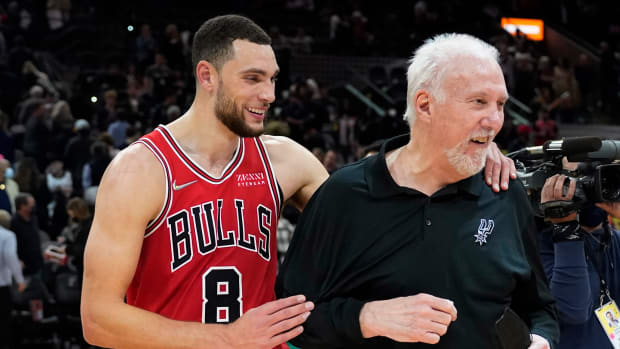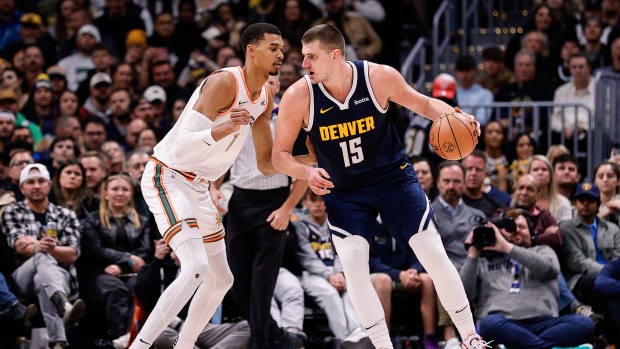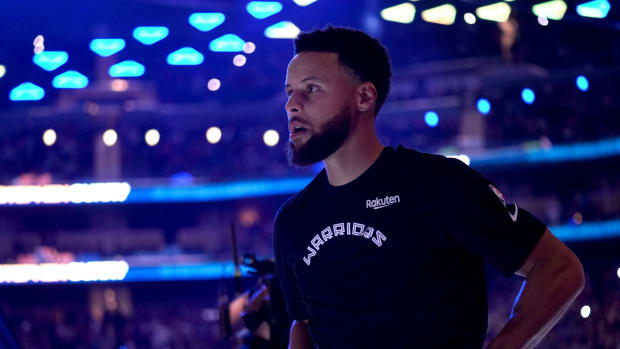Zinger! Kristaps Porzingis is silencing doubters and taking over New York
This story appears in the Jan. 25, 2016, issue of Sports Illustrated. To subscribe, click here.
You have reached your limit of 4 premium articles
Register your email to get 1 more
Kristaps Porzingis sits in stages, folding his 7'3" frame into a leather chair, collapsing his legs under a coffee table, squeezing his elbows inside an arm rest. It is an act of contortion almost as acrobatic as a lefthanded floater in a crowded lane. The NBA is populated by outsized humans, but there is something especially supernatural about the length of Porzingis, which can’t simply be characterized by wingspan measurements at predraft workouts. The first words Hubie Brown said upon meeting the Knicks’ rookie were, “He’s so tall!” Here was a Hall of Fame coach and broadcaster, a fixture in professional basketball for four decades, reduced to an awestruck kid on the street. “He looks bigger than 7'3",” adds Hawks point guard Jeff Teague, evidence of a phenomenon that has already grown larger than life.
When the gymnastics are finished and Porzingis is finally seated, he surveys his opulent surroundings in the lobby of the Atlanta Ritz-Carlton: the marble floors, the crystal chandeliers, the velvet banquettes, the man playing the black baby grand piano, the woman serving the complimentary chicken sliders. He just arrived from New York, where he splits time between high-rise apartments in White Plains and Manhattan, ferried to and from residences in a new Mercedes sedan. Seven months shy of his 21st birthday, he chooses steakhouses over nightclubs, and reports he has acquired a taste for filet mignon. He sleeps on a customized 98-by-80-inch mattress made by one sponsor, sips from a sports drink brewed by another and takes to Instagram to thank a brand ambassador for his biker-denim jeans. When the Knicks travel, they fly on a charter, and the carrier happens to sponsor him as well.
Such are the benefits enjoyed by a tip-dunking, floor-spacing, shot-swatting genetic marvel in America’s hungriest hoops metropolis. The best rookie south of Minneapolis, Porzingis is putting up 13.9 points, 7.9 rebounds and 1.9 blocks, so accurate that he commands attention to 25 feet and so stretchy that he can snatch boards when he appears marooned on the elbow. Porzingis savors all his newfound luxuries, perhaps more than your standard lottery pick, because he remembers so clearly the last time he was a rookie. He was a 15-year-old from Liep-aja, Latvia, dropped off at a dingy dorm in Seville to play in Spain’s ACB League. He lived with two Baloncesto Sevilla teammates, and they only spoke Spanish, which he did not. He was already 6'8", and when he jumped into his twin bed, it always seemed to break. Since his room didn’t have air-conditioning, he would drag the mattress into a suite that did, then sleep on the floor alongside seven others.
Porzingis weighed less than 160 pounds and needed nourishment, but the Spanish food served at the dorm didn't usually agree with him. He earned about $500 a month, and saw plenty of restaurants nearby, but he couldn't stand to part with his spending money. He developed anemia, and by the time he finished the 20-minute walk to the gym every morning for practice he was exhausted. He missed shots he typically made and wondered if his size was hindering his coordination. My hands are too big, he convinced himself. He tweaked his mechanics and his release until his body and brain were fried. He collapsed at night on the little mattress and stared at the ceiling. How can I get out of this contract?.
He went home to Latvia for the holidays, packing dirty laundry because he could never really get his clothes clean. When he returned to Spain, he caught a whiff of his mom’s detergent as he unpacked. The scent, fresh and familiar, nearly wrecked him. I don’t want to be here anymore, I want to go back. He missed the Baltic Sea, a 10-minute walk from his parents’ house, and Frisbee on the beach with friends.
There are a lot of reasons Porzingis stayed in Seville and why, five years later, he inspires chants at Madison Square Garden, rap anthems in Eastern Europe and jersey shortages at the NBA Store. He learned enough Spanish that his teammates respected his effort if not his diction. A nutritionist diagnosed his anemia and dispensed vitamins to treat it. He lost himself in basketball games, YouTube videos and bullfights. But there is another reason he did not rush back to the Baltic.
He couldn’t fail Jānis.
***
Jānis was the first of three sons born to Tālis and Ingrida Porzingis. Tālis, 6'4", was an undersized power forward who played professionally in the Soviet Union. Ingrida, 6'1", starred for Latvian youth national teams. After Tālis retired, he held a variety of jobs, working in a metal factory for one stint and managing the BK Liep-aja basketball club for another. But the Russian financial crisis of 1998 left many across the Eastern bloc unemployed, including Tālis. “Those were very hard times for our family and a lot of other families,” Jānis says. “But then you see the light: Maybe I can play basketball, and make something of myself, and help out.”
A 6'7" sniper, Jānis spent 12 seasons in Europe, bouncing around from the Baltics to Belgium. Tālis eventually landed a job as a bus driver, waking up at 1 a.m. to start his shift, and Jānis sent checks home when he could. “We shared everything we had,” he says. Jānis returned to his parents’ two-story house every summer and shot in the backyard with his brothers, Mārtins and Kristaps, on a wooden slab reclaimed from a local gym that burned down.
• Porzingis or Karl-Anthony Towns? SI experts pick Rookie of the Year
Kristaps, the baby of the family, started playing in first grade for Edvins Sprude, who once coached Ingrida. Sprude could be brutal. “He made me cry,” Kristaps recalls. “But I loved it.” Sprude put Kristaps at point guard, and the oversized floor general polished his handle on the cracked wood out back. Mārtins threw elbows at him, impersonating Kaspars Kambala, the Latvian basketball player-boxer who treated the floor as a ring at UNLV. Kristaps loved that, too. By the time Kristaps turned 11, Jānis joked about becoming his agent and enrolled him in after-school English classes. “Why am I doing this?” Kristaps moaned. Jānis, then 24, explained that he’d someday have to bond with Americans.
Kristaps mastered the language and marinated in the culture. His favorite musician was Drake. His favorite movie was Friday. He begged Jānis for Air Jordans. He cheered for the Lakers, partly because of Pau Gasol, but more so Kobe Bryant. He braided his blond locks into cornrows, inspired by Allen Iverson and Carmelo Anthony, and he watched videos of Kevin Garnett and LaMarcus Aldridge. He discovered new heroes, but Jānis still came first. Kristaps reminisces about his dad, sitting alone in the parked minivan, beaming at Jānis’s tapes on the overhead TV.
In the fall of 2013, Jānis was playing for GKK Sibenik in Croatia when he slipped during practice on an advertising sticker at the top of the key. His hip was broken. The doctor who performed the surgery told him there was a 50% chance he could return at full strength. “I still wanted to play,” Jānis says. “I was 31. I felt better than ever. But I don’t believe things happen just because. I believe they happen for a reason.”
Jānis again considered what was best for the family. His time was coming to an end. His brother’s was just beginning. Jānis retired and headed to Spain, where Kristaps was no homesick wallflower anymore. He was the 7-foot sensation who attracted legendary Spanish coach Aíto García Reneses to Seville, followed in ’14 by decorated NBA assistant Scott Roth. Reneses and Roth had both tutored Gasol early in his career and wondered if they were seeing the next incarnation, minus the opera outings and medical-school ambitions. “Kris does read,” Mārtins says, “but mostly audiobooks.”
When Porzingis details how he survived the early years in Spain, he describes an old laptop that became a loyal companion. He lived on the YouTube channel Dawk Ins, which collected NBA highlights. He’d watch Kevin Durant one day and ask his coaches, “Am I like him?” Then he’d watch Anthony Davis the next and ask the same question. He bookmarked Bryant highlights (“The Kobe Clinic will get you so hyped”) and slam-dunk compilations (“They make me try to dunk so hard”). At 3 a.m. on the road, as his teammates relaxed with movies or video games, he cued up the Clippers and imagined himself on the other end of Chris Paul lobs.
Kristaps deconstructed his own skills with his father, over Skype or FaceTime, the way Jānis once did. “My dad gave me a thousand pieces of advice,” Kristaps says. “Nine-hundred-ninety-nine about basketball and one about life. But that’s O.K.” He did not revolt when Jānis put him through 2½-hour shooting sessions and then made him study NBA press conferences. He had to prepare for everything.
Kristaps was too young to remember the Russian crisis, but he heard the stories. He understood how Jānis gave the family a boost when it needed one, and how his opportunity was approaching. “I wanted to do what my brother did,” Kristaps says. “But he never had a chance to be a great NBA player. He was close, but he never got there. I wanted to finish it.”
***
Many of the scouts and executives who descended on Spain last winter were scared. “They asked so many questions,” Roth recalls. “How tough is he? How long will he need to develop? Does he really love the game?” Since 1998, 18 Europeans had been picked in the lottery, with only Gasol and Dirk Nowitzki making an All-Star team. The busts, like Darko Milicic and Nikoloz Tskitishvili, produced a common Euro stereotype: tall but soft, skilled but aloof. "That cliché hung high over Kris's head,” says Larry Sanders, Sevilla’s former trainer.
• MAHONEY: For the Gasol brothers, basketball is the family business
Roth tried to combat it, underlining the fortitude necessary to endure Spain's junior divisions. “Crappy apartments, crappy gyms, bad balls, bad rims, maybe a jersey, maybe not,” he says. “If you’re good, you go on. If you’re not, you go away.” As recently as last season Porzingis often came off the bench, averaging a pedestrian 11.0 points and 4.6 rebounds in front of crowds that rarely exceeded 2,000.
But opponents, who read mock drafts, saw a natural target. Zinger, as he was called, had alabaster limbs that looked slender enough to snap. “You’d have these 35-year-old men trying to beat the hell out of him,” Roth says, as if describing an army of Kambalas. “Pushing him, bodying him, really knocking him around, and no one called anything.”
The abuse didn’t sap his spirit. Porzingis relished the hyperspeed practices Roth brought from the NBA. He learned the bank shot from assistant coach and former Trail Blazers center Audie Norris. He implemented the Dream Shake. Sanders once mentioned that when Michael Jordan posted up a defender, he felt his man with his legs instead of his back. “It was a really small thing,” Sanders says, “but I noticed Kris doing it the next game.”
Coaches shared those nuggets with scouts, but teams dug deeper. “They talked to me too,” adds former Sevilla wing Derrick Byars, who roomed with Porzingis on the road. “They asked, ‘What are we missing here? Where are the red flags?’”
Byars, who starred at Vanderbilt and spent most of the past decade overseas, had never encountered a young European more in tune with the American experience than Porzingis. It wasn’t just that he listened to Meek Mill, loved Rihanna and comprehended the nuances of the bro hug. He was bred to believe that basketball could be lifeblood. “I can’t back down,” Porzingis says. “I can’t give up. I’m not that guy. That’s the way my parents raised us. That’s the way we are.” Byars eyed him in the weight room. “This is just an example, but lifting in Europe is not a priority the way it is in America,” Byars says. “Most guys don’t want to do it. Kris lifted every off day.”
• GOLLIVER: Knicks receive B as one of NBA’s most surprising teams
Sevilla was a mess last season. The owner ran out of money, players went unpaid and Roth couldn’t obtain a coaching license, relegating him to a glorified team manager. “I couldn’t stand up, I couldn’t call timeout, I couldn’t address the referees or the official scorers,” Roth recounts. “It was a disaster.” Porzingis injected levity into misery, putting his gift of assimilation on display with hilarious impersonations of teammates from all backgrounds. Unlike the stiff image of the 7-foot foreigner, unintentionally funny, Zinger’s humor is genuine. “Tall people problems,” he cracks as he ducks into a crowded elevator, disarming wide-eyed strangers.
“People are just drawn to him,” says Tim Shea. “It’s his charisma, his happiness, his alegria.” Shea was the Knicks’ European scout when they used the No. 15 pick to take 7'2" French center Frédéric Weis in 1999. Shea still remembers the tears in Weis’s eyes when he left the Boston Summer League and headed home, never to play a regular-season NBA game. Shea, a native New Yorker, absorbed endless barbs from his buddies back in Rockaway Beach. Of course he was not the one who selected Weis, but he blamed himself for going along with the pick. “I’m responsible,” he says, “because I didn’t fight hard enough.” Shea is currently out of the league, but he lives in Spain and monitored Porzingis in case anybody wanted his input.
Two days before last June’s draft, Shea fired off a tweet urging the organization to snag Porzingis with the fourth pick. “It wasn’t my job, and I know it was a little bit off the wall,” Shea says. “But I took a lot of s--- because of Frédéric, and I wanted to make sure if I recommended another player to the Knicks I’d have the right perspective.”
Shea's old employer didn't need the tip. Clarence Gaines, a top adviser to Knicks president Phil Jackson, had already been to Seville. “He sent an email to me and Phil that read, ‘Whoever gets the first pick has to consider Kristaps at No. 1,’” Knicks general manager Steve Mills says. The front office was not sold, not yet. “We liked him,” Mills says, “but there was a concern about whether he’d be able to withstand the pressures of this market. Then we met him.”
***
It is the first week of January and the Knicks have matched their win total from last season. But in the visiting locker room at Atlanta’s Philips Arena, they sound less interested in their 17th victory than their rookie’s first technical foul. Porzingis did not do anything egregious, grabbing a loose ball at the same time as Kent Bazemore and staring down the Hawks’ wing when Bazemore ripped it away after the whistle. How the Knicks responded to the exchange was far more revealing than Porzingis’s role in it. Anthony rushed in to confront Bazemore. Center Robin Lopez followed, jawing and gesturing. Players were sent to their respective benches. The Knicks overreacted, which in this rare case may have been the most appropriate reaction of all.
Porzingis was booed at Barclays Center on draft night. Anthony issued a cryptic tweet the next day amid reports that he was unhappy with the selection. Players showed up for summer pickup games at the practice facility expecting another Darko. “I tested him, the way I would anyone,” forward Lance Thomas says. “Body him up, get in him, foul him hard, make him uncomfortable. I wanted to see if the toughness was there. I wanted to see what he does when adversity hits.”
So it goes for Porzingis, and every other Euro, subjected to one macho referendum after another. The Russian crisis, the Seville dorms, the Spanish brutes—none of that was enough. He had to prove his manhood again, here. “Nothing fazed him,” Thomas recalls. “I’d score on him, talk some s---, and then he’d come down and ask for the ball back. He won me over right there. I think he won Melo over as well.”
One summer day Anthony and Porzingis worked out together, then sat on the basket stanchion and talked. “Can you show me that move you just did?” Porzingis asked. Anthony was impressed. In the fall Anthony and Porzingis chatted again, and Porzingis told him about the cornrows. “After that I was like, ‘All right, O.K., I’m riding with you from now on,’” Anthony laughs. “The kid has an aura about him.”
Anthony is enjoying one of his most productive seasons, though not by his usual metrics. His points are down, but so are his shots, and he’s matching a career high for assists. Like Bryant and Gasol, Anthony and Porzingis have developed an intercontinental connection, fostered by the triangle offense and the Zen backdrop. At the Rookie Transition Program every attendee was instructed to grab a book from one of three stacks. Porzingis was interested in a Bill Russell biography, but only two copies remained of Jackson’s Eleven Rings. “I better take this one, quick,” Porzingis told himself. He liked what he read.
• GOLLIVER: Porzingis finishes sixth at forward in NBA All-Star voting
“Phil has installed a culture here that makes people feel challenged but comfortable,” Mills says. “If there’s a mistake, you keep playing, and you don’t focus on what you do wrong. That kind of environment has helped Kristaps, but it’s helped everybody.” The Knicks, demonstrating their newfound alegria, are the most improved team in the NBA.
Success in New York is fraught with peril, but Porzingis’s life remains simple, despite the endorsement deals and brand ambassadors. His primary residence is a three-bedroom apartment which he shares with his parents and brothers in White Plains, 30 miles north of the city near the Knicks’ practice facility. Jānis, as promised, is his agent. Mārtins manages his schedule. Tālis watches League Pass, while learning English, and Ingrida shushes him for nitpicking their son’s post game. “All day, he’s in the same position on the couch,” Kristaps says, miming cheek in hand.
Photos: Porzingis ranked fourth in NBA jersey sales this season
Top 15 Most Popular NBA Jerseys
1. Stephen Curry, Golden State Warriors
2. LeBron James, Cleveland Cavaliers
3. Kobe Bryant, Los Angeles Lakers
4. Kristaps Porzingis, New York Knicks
5. Kevin Durant, Oklahoma City Thunder
6. Derrick Rose, Chicago Bulls
7. Russell Westbrook, Oklahoma City Thunder
8. Kyrie Irving, Cleveland Cavaliers
9. James Harden, Houston Rockets
10. Jimmy Butler, Chicago Bulls
11. Klay Thompson, Golden State Warriors
12. Paul George, Indiana Pacers
13. Anthony Davis, New Orleans Pelicans
14. Chris Paul, Los Angeles Clippers
15. Carmelo Anthony, New York Knicks
Porzingis stays at the facility from 9 a.m. to 3:30 p.m., or until someone tells him to leave. He was overjoyed when the Knicks gave him his own key to the gym, but coaches prefer he doesn’t use it much, preserving his legs for an unexpected playoff chase. At night he still disappears down YouTube rabbit holes, unearthing new motivational clips or roundball classics. He notes that he can study himself these days, too. “He’s lived poorly and now he lives well,” Jānis says. “But he knows why he’s here. He’s here to work. He’s not here to party. He does not associate himself with anything but basketball. When you talk about something else, he doesn’t even see it. He knows who he is. He is pure basketball. It’s beautiful.”
Jānis watches him warming up for a game in Miami. On the other end of the court is Amar’e Stoudemire, a little-used Heat reserve, averaging 3.2 points. Four years ago Stoudemire was the prince of New York, and then it was Jeremy Lin. In the big city, forever seeking a savior, it is hard to separate the fads from the goods. But this craze is built to last. There is nothing insane about it.
Porzingis can handle the ball, as Edvins Sprude intended, and he can protect the rim, as half the Rockets discovered. Zinger blocked seven shots against Houston, seven against Minnesota, six against Orlando, five against Milwaukee. But those weren't even his best performances. He went for 28 points and 11 rebounds against the Spurs, 23 and 13 against the Cavaliers, 29 and 11 against the Hornets. Porzingis thrives in the open spaces of the new NBA, and if Timberwolves center Karl-Anthony Towns does not capture Rookie of the Year, he will be waiting for the putback.
• Eastern Conference resolutions: Knicks should be thankful for Porzingis
Porzingis is still adjusting to his length, while padding his frame with high-calorie breakfasts. He gestures as he speaks, and when he does, he knocks his phone off an armrest and onto the floor. He worries he cracked his screen. You imagine the damage he will wreak when he gains full control over his limbs.
After the Knicks beat the Heat, Stoudemire dresses in the home locker room, no TV cameras around. In 2011 he lived in a Meatpacking District apartment, complete with a billiards room, recording studio and replica barber shop. He ate herb-crusted chicken and challah bread, prepared by his kosher chef, and he soaked up views of the Empire State Building. This was back when Madison Square Garden was serenading him with MVP chants, Kanye West was flanking him after games and Walt Frazier was calling him a rock star.
Stoudemire, now 33, mentions that he has sold the apartment. “Everything in New York changes like the weather,” he says. “As long as this kid understands there will be good days and bad days, good years and bad years, he’ll be fine. Because he’s not like the guys who came over here and didn’t pan out.
“This time it’s going to work.”

















































